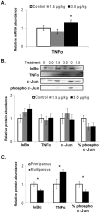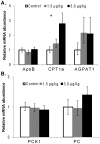TNFα altered inflammatory responses, impaired health and productivity, but did not affect glucose or lipid metabolism in early-lactation dairy cows
- PMID: 24260367
- PMCID: PMC3833956
- DOI: 10.1371/journal.pone.0080316
TNFα altered inflammatory responses, impaired health and productivity, but did not affect glucose or lipid metabolism in early-lactation dairy cows
Abstract
Inflammation may be a major contributing factor to peripartum metabolic disorders in dairy cattle. We tested whether administering an inflammatory cytokine, recombinant bovine tumor necrosis factor-α (rbTNFα), affects milk production, metabolism, and health during this period. Thirty-three Holstein cows (9 primiparous and 24 multiparous) were randomly assigned to 1 of 3 treatments at parturition. Treatments were 0 (Control), 1.5, or 3.0 µg/kg body weight rbTNFα, which were administered once daily by subcutaneous injection for the first 7 days of lactation. Statistical contrasts were used to evaluate the treatment and dose effects of rbTNFα administration. Plasma TNFα concentrations at 16 h post-administration tended to be increased (P<0.10) by rbTNFα administration, but no dose effect (P>0.10) was detected; rbTNFα treatments increased (P<0.01) concentrations of plasma haptoglobin. Most plasma eicosanoids were not affected (P>0.10) by rbTNFα administration, but 6 out of 16 measured eicosanoids changed (P<0.05) over the first week of lactation, reflecting elevated inflammatory mediators in the days immediately following parturition. Dry matter and water intake, milk yield, and milk fat and protein yields were all decreased (P<0.05) by rbTNFα treatments by 15 to 18%. Concentrations of plasma glucose, insulin, β-hydroxybutyrate, non-esterified fatty acids, triglyceride, 3-methylhistidine, and liver triglyceride were unaffected (P>0.10) by rbTNFα treatment. Glucose turnover rate was unaffected (P=0.18) by rbTNFα administration. The higher dose of rbTNFα tended to increase the risk of cows developing one or more health disorders (P=0.08). Taken together, these results indicate that administration of rbTNFα daily for the first 7 days of lactation altered inflammatory responses, impaired milk production and health, but did not significantly affect liver triglyceride accumulation or nutrient metabolism in dairy cows.
Conflict of interest statement
Figures




References
-
- Grummer RR (1995) Impact of changes in organic nutrient metabolism on feeding the transition dairy cow. J Anim Sci 73: 2820–2833. - PubMed
-
- Grummer RR (2008) Nutritional and management strategies for the prevention of fatty liver in dairy cattle. Vet J 176: 10–20. - PubMed
-
- Oetzel GR (2007) Herd-level ketosis: diagnosis and risk factors. In: Am Assoc Bov Pract Proc. Vancouver, BC, Canada. pp. 67–91.
-
- Bobe G, Young JW, Beitz DC (2004) Invited review: pathology, etiology, prevention, and treatment of fatty liver in dairy cows. J Dairy Sci 87: 3105–3124. - PubMed
-
- Young JW (1977) Gluconeogenesis in cattle: significance and methodology. J Dairy Sci 60: 1–15. - PubMed
Publication types
MeSH terms
Substances
LinkOut - more resources
Full Text Sources
Other Literature Sources
Molecular Biology Databases

